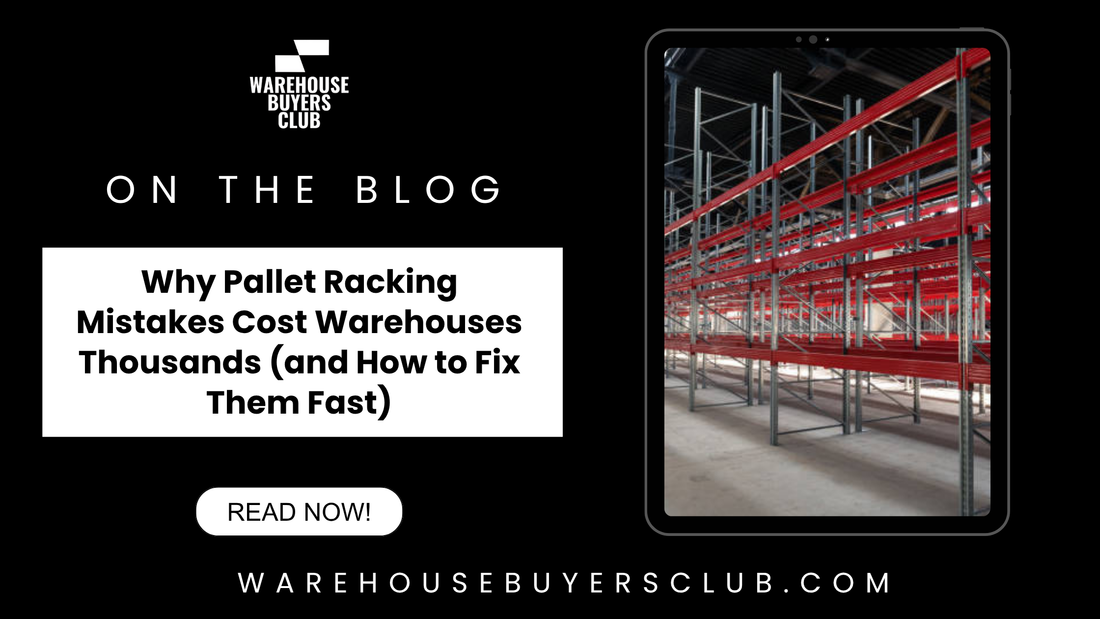𝑾𝒉𝒚 𝑷𝒂𝒍𝒍𝒆𝒕 𝑹𝒂𝒄𝒌𝒊𝒏𝒈 𝑴𝒊𝒔𝒕𝒂𝒌𝒆𝒔 𝑪𝒐𝒔𝒕 𝑾𝒂𝒓𝒆𝒉𝒐𝒖𝒔𝒆𝒔 𝑻𝒉𝒐𝒖𝒔𝒂𝒏𝒅𝒔 (𝒂𝒏𝒅 𝑯𝒐𝒘 𝒕𝒐 𝑭𝒊𝒙 𝑻𝒉𝒆𝒎 𝑭𝒂𝒔𝒕)

When it comes to running a warehouse, pallet racking often gets treated as a “set it and forget it” investment. Once it’s installed and loaded, most warehouse managers move on to the next operational priority—until something goes wrong.
But here’s the truth: even small pallet racking mistakes can quietly drain thousands of
dollars through damaged goods, downtime, and costly repairs. Worse, they can put your team’s safety at risk. Whether it’s improper installation, uneven load distribution, or simply using the wrong type of racking for your inventory, the financial and operational fallout can be significant.
At Warehouse Buyers Club, we’ve helped warehouses across the nation recover lost efficiency and prevent accidents by fixing these common mistakes. In this post, we’ll explore the most frequent pallet racking errors, their hidden costs, and how you can fix them fast.
1. The Hidden Cost of Poor Racking Installation
Pallet racks are designed to carry heavy, dynamic loads—but only when installed correctly. When beams aren’t secured, uprights aren’t level, or anchors aren’t properly fixed to the floor, your entire racking system becomes a ticking time bomb.
A single improperly installed rack can cause:
· Structural instability, increasing the risk of collapse
· Product damage, from fallen pallets or uneven loads
· OSHA safety violations, leading to costly fines or shutdowns
Fix it fast: Always ensure that installation is done by certified professionals and that your racking meets local safety codes. If your racks were installed years ago, schedule a professional inspection to confirm they still meet current standards. Warehouse Buyers Club connects you with trusted vendors offering both new and used racking systems that meet all safety requirements.

2. Ignoring Weight Limits and Load Distribution
Not all racks are created equal. Each system is engineered for specific weight capacities and load patterns. Exceeding these limits—even by a small margin—can cause beams to sag or fail.
Over time, uneven weight distribution puts unnecessary stress on the uprights, leading to long-term deformation and potential collapse.
Fix it fast:
· Know your rack’s maximum load rating (check the manufacturer’s label or documentation).
· Train staff to evenly distribute weight across beams and shelves.
· If your inventory mix changes frequently, consider adjustable racking or heavy-duty beams that can adapt to varying loads.
At Warehouse Buyers Club, we’ve seen warehouses save up to 20% in space efficiency by upgrading to the right racking solution. It’s not just about holding more—it’s about holding smarter.

3. Overlooking Regular Safety Inspections
Another major oversight is skipping routine racking inspections. Just because a rack looks stable doesn’t mean it is. Small dents, misaligned beams, or loosened bolts can all compromise integrity over time—especially in high-traffic operations where forklifts are constantly moving.
Neglecting safety checks can lead to:
-
Undetected damage that worsens over time
-
Unexpected downtime for repairs or replacement
-
Injury risks that hurt both people and productivity
Fix it fast:
Implement a monthly visual inspection checklist and schedule annual professional audits. Make sure to document findings and address issues immediately. A preventive approach can save thousands in future repair costs and help you stay compliant with OSHA and local regulations.
Warehouse 101: Did You Know?
Here are a few quick facts that might surprise even experienced warehouse pros:
· Over 80% of racking collapses are caused by improper installation or overloading—issues that are entirely preventable.
· A single damaged upright can reduce a rack’s load capacity by up to 40%.
· Conducting quarterly safety audits can cut maintenance costs by 25% in the long term.
· Adjusting your beam spacing and pallet size can unlock 15–20% more storage space—without expanding your facility.
· Investing in the right pallet racking system can improve workflow efficiency by up to 30%, especially in high-turnover operations.
💡 At Warehouse Buyers Club, we help businesses identify these hidden opportunities every day through expert-led warehouse optimization solutions.
4. Using the Wrong Type of Pallet Racking System
Every warehouse is different—and so are the products stored inside. Using a one-size-fits-all approach to pallet racking is one of the fastest ways to waste money and space.
Here are a few common mismatches:
· Selective racks used for high-density storage (causing wasted space)
· Drive-in racks where fast access is needed (reducing picking efficiency)
· Push-back or flow racks misused for uneven pallet sizes (causing jams or product damage)
Fix it fast:
Evaluate your inventory type, turnover rate, and available floor space to choose the right system. For example:
· Selective racking for versatility and easy access
· Drive-in/drive-through systems for high-density, low-turnover goods
· Pallet flow or push-back racks for high-volume operations that prioritize rotation
At Warehouse Buyers Club, our marketplace offers expert-guided racking solutions that match your specific storage needs, ensuring both safety and efficiency.

5. Neglecting Employee Training
Even the best racking system can fail if your team isn’t trained to handle it properly. Forklift collisions, uneven pallet loading, and improper stacking are all human errors that can cause major racking damage.
Fix it fast:
Provide regular training sessions that cover safe loading practices, weight limits, and damage reporting procedures. Encourage employees to report issues immediately—small fixes today prevent costly failures tomorrow.

6. Missing Out on Space Optimization Opportunities
Sometimes, the problem isn’t safety—it’s efficiency. Many warehouses operate with underutilized vertical or horizontal space simply because their racking isn’t configured correctly.
Adjusting factors like:
· Beam spacing
· Rack depth
· Pallet size and type
…can dramatically improve space utilization. Our team has seen facilities reclaim up to 20% more usable space just by reconfiguring their racks to fit their inventory profile.
Fix it fast:
Use a warehouse layout audit to identify wasted space and optimize traffic flow. Warehouse Buyers Club provides expert consultation to help you design or retrofit your racking system for maximum capacity and performance.
The Bottom Line
Pallet racking is more than just steel and bolts—it’s the backbone of your warehouse operation. When installed and maintained properly, it keeps your team safe, your products secure, and your operations running efficiently. When neglected, it quietly eats into your profits.
Don’t let racking mistakes cost your warehouse thousands. Instead, take control by investing in proper installation, regular inspections, employee training, and system upgrades tailored to your operation.




